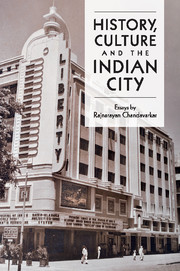Book contents
- Frontmatter
- Contents
- Acknowledgements
- Publisher's note
- Introduction by Dr Jennifer Davis, Wolfson College, University of Cambridge
- Bombay's perennial modernities
- Sewers
- Peasants and proletarians in Bombay city in the late nineteenth and early twentieth centuries
- State and society in colonial India
- Religion and nationalism in India
- From neighbourhood to nation: the rise and fall of the Left in Bombay's Girangaon in the twentieth century
- Historians and the nation
- Urban history and urban anthropology in South Asia
- Aspects of the historiography of labour in India
- Postscript by Professor David Washbrook, Trinity College, University of Cambridge
- Bibliography of the published works of Rajnarayan Chandavarkar
- Index
- References
Peasants and proletarians in Bombay city in the late nineteenth and early twentieth centuries
Published online by Cambridge University Press: 17 March 2010
- Frontmatter
- Contents
- Acknowledgements
- Publisher's note
- Introduction by Dr Jennifer Davis, Wolfson College, University of Cambridge
- Bombay's perennial modernities
- Sewers
- Peasants and proletarians in Bombay city in the late nineteenth and early twentieth centuries
- State and society in colonial India
- Religion and nationalism in India
- From neighbourhood to nation: the rise and fall of the Left in Bombay's Girangaon in the twentieth century
- Historians and the nation
- Urban history and urban anthropology in South Asia
- Aspects of the historiography of labour in India
- Postscript by Professor David Washbrook, Trinity College, University of Cambridge
- Bibliography of the published works of Rajnarayan Chandavarkar
- Index
- References
Summary
To a remarkable extent, historians and sociologists of widely differing intellectual traditions appear to have converged upon broadly similar approaches to the study of a migrant working class. Modernization theorists, neoclassical economists and sociologists of development have been preoccupied with the adaptation of a rural workforce to an urban and industrial setting and have tended to portray protest largely as a response to this process of adaptation. The form and content of labour protest in this view is determined by the extent of industrial development. Thus, while labour protest in the initial stages of industrialization is characterized by spontaneity and violence, the organization of trade unions and skills of negotiation and formal collective bargaining are said to be the achievement of a working class in a more advanced stage of its formation. Within the Marxist tradition, such teleology stems not from the rational allocation of resources, and in the case of migrant labour its most efficient deployment and control, but from the ontological role of the working class, in its full proletarian maturity, as the agent of transition to socialism. In either case, and of course there are several varieties of each, the migrant character of the workforce has symbolized a transitional phase in the making of the working class between its original peasant status and its fully developed proletarian character. Many of the existing approaches to the subject offer a teleological rather than a contextual perspective; and to that extent tend towards the ahistorical.
- Type
- Chapter
- Information
- History, Culture and the Indian City , pp. 59 - 82Publisher: Cambridge University PressPrint publication year: 2009
References
- 12
- Cited by



